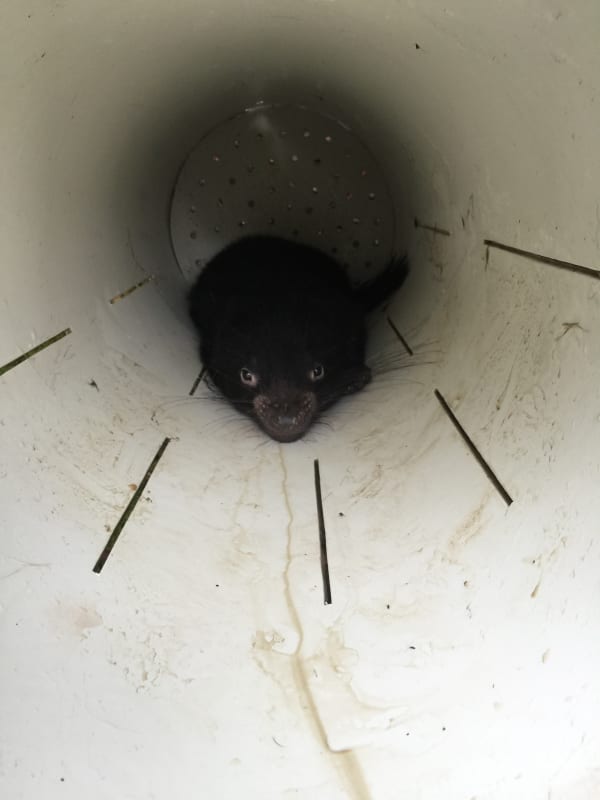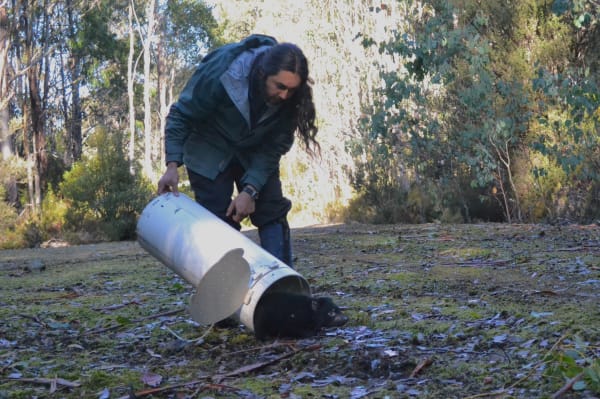On one of our final days we met Taupo, a two-year old female harbouring four tiny babies. Gently, we peered inside her pouch and saw furless, squirming jellybeans, each one oblivious to our interest and focused only on the teat vacuumed firmly into their mouths. In a few short months this new generation will leave the safety of the pouch and meet the challenges faced by their parents and cousins. Bright minds like Rodrigo Hamede will continue working to understand and protect the Tasmanian devil, but the catalogue of threats facing them mean that there is still a long way to go before the future of this iconic Australian species is assured.
. . .
It is dark, pre-dawn, and I am already up, pulling on warm layers before I face the freezing temperatures outside. Thermals, woollens, two pairs of thick socks, insulating outer shell … it all feels stifling inside the warm cabin, but as soon as I step outside the chill begins to creep around buttons and through zippers. It is only May, but winter has already arrived in the mountains.
I am at Cradle Mountain to assist researchers from the University of Tasmania to trap and sample wild devils. Disease ecologist Rodrigo Hamede has been coming here every three months since 2006 to study the impact of devil facial tumour disease (DFTD) and, this time, he has enlisted me and veterinarian-turned-PhD-candidate Tammy Shadbolt as volunteer assistants for the next ten days.
Late yesterday afternoon we laid 40 tubular PVC traps at the research site 20 minutes away, and we want to get back to them early so that no animal is contained too long.
Our ute is covered in a thick layer of ice and we must pour buckets of water over the windows before we can go anywhere.
The gate that locks the entrance to the site is heavy and difficult to open at the best of times; with early-morning ice in the barrel, it takes two of us to unlock it and swing it open. It has snowed overnight and as we begin our rounds, the forest is still and quiet, the usual noises muffled by a white blanket.
We begin to revisit the traps, progressing systematically from number one to number 40. The first trap is closed when we arrive and Tammy and I watch optimistically as Rodrigo checks inside. A shake of his head tells us that it is empty, the tasty meaty bait stolen by a cat clever enough not to get caught in the trap. Feral cats pose a serious threat to wildlife across most of Australia but in Tasmania, where the number of top predators like devils and quolls are in decline, cats are flourishing unimpeded.

We record the loss, clean the trap, rebait it and keep going.
Before long, we find our first devil. At two years old Koru is in his prime but he lies silent and still, even as Rodrigo’s arm is extended deep into the trap to scan his neck for a microchip. Scan complete, he is upended as smoothly as possible into a hessian sack, weighed, and carried to the examination site. Rodrigo sits on the ground, sack in his lap, and manipulates the hessian until Koru’s snout is exposed, his hand wrapped carefully around it to prevent bites.
I have worked alongside captive Tasmanian devils for years but this is the first wild devil I have seen and he fascinates me. Captive devils are generally confident critters who like to wrestle with boots and buckets and have no qualms demanding more food. The species has a reputation for ferocity and Koru is a warrior – at almost 10 kilograms he is a big devil, with a snout lined with his first battle scars and a squat body and thick neck indicating the strength within. But like most wild devils, this furry gentleman has frozen in fear of us and lets Rodrigo check and measure his ears, teeth, tongue and snout for signs of injury or tumour. Having encountered Koru before, Rodrigo has already compiled a complete set of biological data (ear biopsy, whisker and hair samples, inserting a microchip) and today it is simply a standard blood sample and once-over to ensure he is still healthy.
The work requires at least two people – one to handle the animal, the other to pass equipment and record the data – and Rodrigo relies on volunteers to assist him on each trip. He teaches us the correct process, followed exactly the same each time, of data entry, labelling, sample storage and biosecurity measures. It must be frustrating to train new volunteers each time, but he waits as we slowly search for the correct spot on the datasheet, or collect the requisite vials and labelling equipment.
With a final check for injuries on body, feet and tail, the examination is over. Once Rodrigo is satisfied that the data has been recorded properly, the sack is carried nearer to the scrub and the end opened. Wasting no time, Koru bounds out and disappears, tail flicked high behind him. Tammy and I grin at each other, silently congratulating ourselves for staying cool around our first wild devil.
The smiles remain as we disinfect the equipment and pack it away, then turn our attention to the soiled trap. Koru spent hours in there before we arrived and the evidence of his stay must be flushed away: shake out the debris, squirt with disinfectant, scrub thoroughly, rinse with water, rebait, reset. Off we go to the next trap.
Over the course of the day we find four devils. Rodrigo greets each one like an old friend, murmuring “hello darling” and “my beauty” as he works, and gives the new ones names based on themes. So far this year it has been towns in Bolivia and Mexico and I struggle to understand Rodrigo’s rapid-fire pronunciation of them. He takes a cheeky delight in selecting especially long names and watching as we struggle to spell them on the datasheet. Uchupiamonas, Ixhuatlan, Ayotzinapa. I am relieved when simpler options are suggested: Potosi, Santa Cruz, Beni.
We break for lunch in a small clearing, setting up our simple picnic on a lichen-covered log. Ancient myrtle and Tasmanian pepperberry heavy with fruit surround our lunch spot and give perch to curious currawongs hopping in close to inspect us. We do not linger long; Rodrigo works with the focus and energy of a man with too much to do and doesn’t even take the time to don a warmer jacket until it starts to snow and he begrudgingly admits that he’s feeling a little cold.
Each time we stop at a trap, we repeat the process, and bit-by-bit Tammy and I get quicker, remembering the next step and preparing the materials for Rodrigo in advance. This means that when we come across the inevitable DFTD, the three of us have begun to click as a team. A few devils have small dimpled tumours only just showing, while others have larger, angry-looking lesions. Each one must be carefully measured, photographed and biopsied so that Rodrigo and his colleagues can study the disease in molecular detail back in their lab.
None of these devils, however, prepare us for three-year-old Matariki, with tumours so advanced they have eaten away her entire lower jaw. At a skinny four kilograms, she is by far the smallest devil we have come across.
We are all silent, taking in this animal in such a horrendous condition. Rodrigo works quickly, taking only the basic measurements – weight, tail width, head width, the length of her remaining teeth. She is missing so many that the dental exam doesn’t take long and soon the hessian is gently reclosed.
To save her further exertion, Rodrigo carries the sack into the scrub to find her den and releases her next to it. Over the remaining days of the survey, we watch for Matariki in the same spot, but she does not reappear.
Matariki’s case is extreme, and Rodrigo admits that he has seen only a handful of devils in her condition in all the time he has been working with the species. Nonetheless, she is a stark example of the suffering the disease can cause and motivates researchers like Rodrigo to continue their efforts to protect the species. At several sites around Tasmania, they have been noticing signs that the devil may be adapting to the disease: females beginning to breed at younger ages and breeding seasons extending in length. Rodrigo’s work has also begun to reveal other hopeful developments, with six of the devils trapped at Cradle Mountain found to be showing an immune response to the disease.
However, with ongoing challenges in the development of a vaccine, and in the face of other threats like roadkill, dog attacks, feral cats and habitat destruction, wild devil population growth is likely to remain low for the foreseeable future. This makes the species vulnerable, and less able to adapt to events like environmental change and outbreaks of new diseases.
In light of all this, it was heartening when we came across naïve one-year-olds only just away from mum, knowing that this shows a population that is breeding. More than half the devils we trapped on the trip were born the previous year and their fresh faces and wide eyes took in a world still new to them.
On one of our final days we met Taupo, a two-year old female harbouring four tiny babies. Gently, we peered inside her pouch and saw furless, squirming jellybeans, each one oblivious to our interest and focused only on the teat vacuumed firmly into their mouths. In a few short months this new generation will leave the safety of the pouch and meet the challenges faced by their parents and cousins. Bright minds like Rodrigo will continue working to understand and protect the Tasmanian devil, but the catalogue of threats facing them mean that there is still a long way to go before the future of this iconic Australian species is assured.
Read more: A devil named Prada, Grace Heathcote
Grace Heathcote is a Tasmanian writer. With a background in ecology and conservation. She focuses largely on these topics in her writing but has a soft spot for all things Tasmanian. Published nationally, including in The Guardian, she has also had academic papers accepted to peer-reviewed journals Conservation Biology and Wildlife Research.









